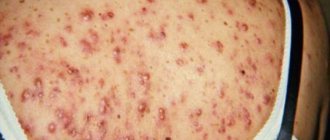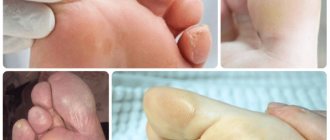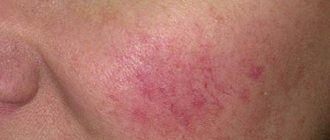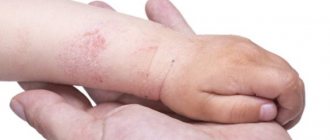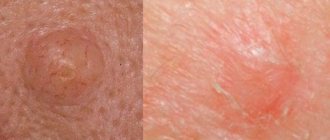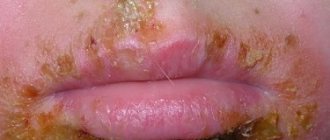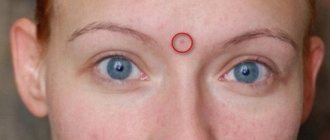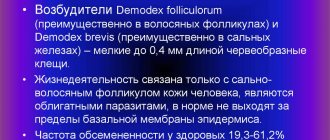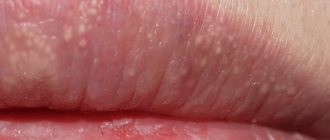Rosacea (or, as they are also called, rosacea) is a facial skin disease that occurs in a chronic form with relapses, characterized by damage to the sebaceous glands, hair follicles and skin capillaries. The disease is one of the most common in dermatological practice: according to medical statistics, it affects about 10% of patients. Most often it affects fair-skinned people, in particular women over the age of thirty.
The dermatovenereology department of CELT offers a course of treatment for rosacea in Moscow. Our clinic has been operating in the paid medical services market for almost 30 years and has a powerful diagnostic and treatment base. Thanks to it, our specialists are able to accurately diagnose and individually select treatment that will be carried out in accordance with modern international standards.
At CELT you can consult a dermatologist.
- Initial consultation – 3,200
- Repeated consultation – 2,000
Make an appointment
Pathogenesis of rosacea
Of great importance in the pathogenesis of rosacea is the type of human skin and his belonging to a particular race. For example, the Irish and other representatives of northern peoples are more often susceptible to the disease. Statistics show that rosacea occurs in 40% of the total population of this contingent, while representatives of the Negroid race, as well as Asians, almost never suffer from rosacea.
Rosacea occurs in both men and women, but more often they affect women with blond hair and whose photosensitivity is type 1 or 2.
Provoking factors
Typically, the occurrence of rosacea is provoked by overheating in the sun or, on the contrary, excessive hypothermia, as well as insolation, including exposure to ultraviolet rays of a solarium. Stress and prolonged use of glucocorticosteroids are also provocateurs leading to the development of rosacea.
Rosacea can be caused by improper skin care, while using harsh scrubs or other harsh chemicals (such as chemical peels) - all this leads to the expansion of the vascular network, and this is already a cosmetic problem, which can continue to develop into rosacea. .
Interestingly, those who abuse alcoholic beverages, eat spicy or spicy foods, and smoke are more likely to suffer from rosacea. In the case of an already established disease, such factors will only aggravate it. The condition of rosacea is also influenced by allergic reactions with various dermal manifestations.
It is also interesting that if mites are present in the follicles, the symptoms of rosacea will intensify, but you should not mistakenly assume that demodex mites are the cause. It is because of this erroneous opinion that incorrect treatment is often prescribed, which only complicates the course of the disease itself.
There is no specific cause of rosacea (or obvious pathogenesis) in its development, but a combination of certain factors may increase the likelihood of its occurrence. It should be said that in the pathogenesis of rosacea, the microflora itself will not be a provoking factor, but sometimes the disease can be complicated by gram-negative pyoderma.
Therapeutic measures
When diagnosing rosacea on the face, the causes and treatment are closely interrelated elements. First of all, the dermatologist will try to find out the cause and begin treatment by eliminating it.
Therapeutic tactics are selected in accordance with the stage of the disease, the gender of the patient, and the presence of underlying diseases.
Treatment of periodic hot flashes
At the first stage, local drugs that have a vasoconstrictor effect are prescribed. Cold lotions of resorcinol and boric acid are used. They constrict blood vessels and thereby help eliminate burning and itching.
It is imperative to carry out hygiene procedures using gels that have sebum-regulating and anti-inflammatory effects. In this situation, gels and lotions from the same series are used as for caring for problem skin with acne.
If spider veins, persistent redness, or a feeling of skin tightness appear, a cream from the pharmaceutical cosmetic line Diroseal is prescribed.
Medium and severe stage therapy
Previously, when rosacea formed on the face, treatment was carried out with local corticosteroid drugs. Long-term use of such drugs often leads to the transition of the disease to another stage, which is characterized by persistent spider veins and spider veins, tissue atrophy, the appearance of age spots and pustular rashes. Therefore, recently steroid hormones are not recommended for local therapy.
When lumpy elements in the form of papules and pustules form on the face, local antibiotics, mainly of the tetracycline series, are prescribed, since it is tetracyclines that can accumulate selectively in the area of the sebaceous glands and eliminate inflammation. Treatment with antibiotics is long-term (3 months) and very often leads to adverse reactions in the form of allergies, disruptions in the gastrointestinal tract, and reactions to the sun.
Macrolides, in particular Erythromycin, are also used among antibiotics. A five-week course of Erythromycin ointment is prescribed 2 times a day. Longer use of an antibiotic leads to microflora resistance and ineffectiveness of the drug.
A drug such as Zinerit, which contains erythromycin and a zinc compound, has proven itself well. The solution relieves inflammation and has a detrimental effect on pathogenic microflora. Treatment time is at least 3 months.
Treatments for rosacea on the face are used, the main active ingredient of which is azelaic acid - Skinoren, Azelik, AcneStop, etc. They have an anti-inflammatory effect, are destructive to bacteria, and also soften the stratum corneum of the epidermis and promote cell renewal. The drugs are used 2 times a day. A noticeable change in skin condition is observed no earlier than after a month of regular use.
If necessary, treatment is also carried out with vitamins and antihistamines.
Products such as retinoids, synthetic derivatives of vitamin A (retinol), have found widespread use:
- Tretinoin cream - a course of therapy of 1.5 months with twice a day application.
- Adapalene - used once a day before bedtime. Improvement occurs after long-term (3 months) use. Treatment begins with the gel, but if side effects occur in the form of burning and peeling, switch to cream. Contraindicated during pregnancy and lactation.
- Retinoic ointment is an anti-acne, antiseborrheic and anti-inflammatory drug. It is not recommended for use during pregnancy and for girls planning to become pregnant. Before applying the product, you should take into account the fact that it cannot be combined with other retinoids and topical tetracycline-based drugs.
Prescribed drugs based on metronidazole (synthetic antibiotic):
- Metrogyl gel;
- Rosamet face cream for rosacea.
In any case, whether this or that medicine can be used is determined exclusively by a dermatologist and often together with a gynecologist or ophthalmologist.
When rosacea reaches a stage with the formation of pustules with purulent contents, systemic retinoids and, above all, isotretinoin (Roaccutane) are prescribed. Before treating rosacea on the face with systemic medications, it is imperative to consult a doctor due to numerous side effects and a significant list of contraindications.
The advanced stage of the disease, which is characterized by skin growths, can be treated mainly by surgical methods.
Diet
Diet for facial rosacea is one of the components of complex treatment.
The daily diet menu should exclude foods that cause redness and irritate the stomach: alcoholic drinks, coffee, citrus fruits, spicy dishes with a lot of spices.
It is recommended to eat food warm. It is necessary to reduce the consumption of foods high in iodine, as this substance can trigger the reappearance of rosacea.
Skin care and lifestyle
When rosacea is diagnosed, treatment will be more effective with proper hygienic and cosmetic facial care.
Patients with hypersecretion of the sebaceous glands, wide pores and a tendency to form comedones are recommended to use gels and lotions for washing, which have a sebum-regulating effect (normalize sebum production) and an anti-inflammatory effect. It is very important that cosmetic products do not disturb the water-lipid mantle (protection) of the skin. Therefore, their pH level should not exceed 7 units.
It is recommended to carry out hygienic facial skin care using the following gels and lotions:
- Klerasil Ultra;
- Cleanance;
- Keraknil;
- Cetaphil;
- Aven.
Caring for problematic facial skin helps soften the epidermis, open pores, remove dead cells and moisturize. Cleansing products should not be used more than 2 times a day.
During treatment, side effects such as dryness and flaking often occur. Therefore, cosmetics for rosacea on the face must include moisturizing creams:
- Klin AK;
- Aven;
- Anti-rouger;
- Rosaliak;
- Sensibio AR.
All these products moisturize well, eliminate the feeling of discomfort and improve the tolerability of medications.
Folk remedies
Treatment with folk remedies is most effective at the first symptoms of rosacea. First of all, lotions from decoctions of plants such as chamomile, sage, calendula, marshmallow and tea are used. The decoctions are prepared in a water bath for a quarter of an hour, then infused for another 30-40 minutes at room temperature.
A prerequisite is that the liquid must be cold. Lotions constrict blood vessels and soothe the skin.
Face masks for rosacea based on kefir and oatmeal are also effective. These two components are used to prepare monomasks. Kefir is applied to the face and left for 10-15 minutes. Oatmeal is brewed in boiling water, left for an hour and spread over the face.
Important! You cannot use self-heating masks that are commercially available in the “anti-acne” category.
Physiotherapy
Physiotherapeutic methods are used to treat dilated blood vessels, eliminate hyperpigmentation and scar changes.
The following methods are used:
- electrophoresis;
- cryomassage;
- electrosurgery;
- laser therapy.
To eliminate skin changes, dermabrasion (only in the complete absence of inflammation on the face) and various chemical peels are used. If you are prone to scarring, Contractubex gel may be prescribed.
Symptoms of rosacea
If we talk about the prodromal period of the formation of the disease, then it is characterized by sharp hot flashes observed on the skin of the face. Such hot flashes are usually accompanied by a feeling of heat. Typically, hot flashes appear as a response to stimuli that are not significant in strength. It is known that even small doses of alcoholic beverages can cause persistent expansion of the vascular network on the face. At the very first stage of development of rosacea, this blush is very bright, having a clearly defined border with healthy skin. It happens that the blush resembles flames or rose petals in appearance.
If we are talking about the first stage, then most often there is erythema of the facial skin, which occurs without provoking factors. An increase in skin oiliness also occurs due to the use of certain cosmetic preparations, which are precisely aimed at reducing oiliness. There are disturbances in hydroexchange, the development of seborrhea, and as a result - a significant amount of separated sebum.
The second stage is characterized by the formation of rosacea not only in the form of constant redness, but also in the form of telangiectasia, as well as papules and pustules of insignificant size.
The third stage is characterized by the manifestation of rosacea in the form of pronounced erythema, as well as a dense network of so-called telangiectasia, which is clearly manifested in the area of the wings of the nose and on the chin, as well as in the form of papules and pustules. Depending on its type, nodules and dense infiltrates can form on the skin, located in the central part of the face.
The course of the disease is usually wave-like, periods of remission or exacerbations may occur, however, over time, the duration of such remissions will decrease, and exacerbation of rosacea will only become more frequent, and each subsequent relapse in its clinic will be longer than the previous one. The time will come when remissions will no longer be observed, when pathogenic microflora will be identified, after which the infiltrative stage will begin - all the skin will be thickened, swollen and inflamed.
Stages of rosacea
Rosacea goes through several stages in its development. During the prodromal period, symptoms do not yet appear, but the person is already beginning to experience hot flashes.
- The first stage is a persistent blush on the skin and a vascular pattern.
- The second stage is the formation of nodules and pustules.
- The third stage is the formation of foci of infiltration.
Rosacea occurs in waves: exacerbations are replaced by remissions.
Diagnosis of rosacea
Usually, a dermatologist is able to make a diagnosis based on the findings of a simple visual examination. An important sign during diagnosis is the absence of comedones and blackheads on the face. Additional studies may also be prescribed for the purpose of differentiated diagnosis. The doctor may prescribe a bacterial culture and bacteriological examination to determine the contents of the pustules, which allows to exclude the presence of a staphylococcal infection or any other pyoderma.
The use of microscopic examination (for demodex) will make it possible to more accurately determine the tactics of treating rosacea, which was complicated by demodicosis.
Symptoms and signs of the disease
First, red spots form on the affected area of the skin, and the skin around them becomes bright pink. The inflammatory reaction stimulates the sebaceous glands, the upper layer of the epidermis becomes excessively oily. The use of cosmetics that have a drying effect turns out to be useless. It does not improve the condition of the skin, but, on the contrary, worsens it. The top layer of the epidermis begins to peel off greatly.
Since inflammation affects not only the sebaceous glands, but also small vessels, their walls expand, capillaries and veins lose their elasticity. As a result, characteristic red or blue stars appear on the face.
In place of the vascular pattern, individual pustules may form. Doctors call this phenomenon rhinophyma. Pimples appear on swollen skin in the form of rashes. They are dome shaped. Pimples fester over time, and a dense infiltrate appears underneath them.
Treatment of rosacea
As is known, in the first stages, rosacea does not manifest itself with clinical signs, since any flaws can be masked with the help of cosmetics, but it is most effective to begin treatment of the disease at this stage. Doctors prescribe medications that can strengthen the vascular wall, and carry out sedative therapy using herbal-based drugs, which reduces nervous excitability, reducing the release of adrenaline into the blood. Thus, the vascular network will not expand, and the external severity of rosacea will gradually subside. The use of vitamins A, B and C, as well as the introduction of subcutaneous injections containing nicotinic acid, will strengthen the walls of blood vessels, while stabilizing the autonomic nervous system.
Doctors recommend washing your face regularly with chamomile or horse chestnut infusion. The latter gives a particularly good local effect, soothing the skin in the presence of rosacea.
It should be noted that the presence of demodex mites at this stage cannot be considered as an indication for the treatment of demodicosis. On the contrary, such treatment only worsens the patient’s well-being. The demodicosis itself will go away after the follicles begin to work in their usual mode, while the sebum secretion will decrease.
In the second and third stages of rosacea development, topical application of various gels containing antibiotics (as well as metronidazole) will be required. It is these drugs that can have an anti-inflammatory effect, cooling the surface that has been affected by rosacea.
If the occurrence of acne was not caused by prolonged use of glucocorticosteroid ointments, then the use of short-term local therapy with these ointments (for example, Sinaflan) will quickly help relieve infiltrative inflammation caused by rosacea.
After stopping the inflammatory process, it is necessary to eliminate the main cause of rosacea, namely the dilated vascular network, which is also branched. Photocoagulation, laser coagulation or electrocoagulation will help solve this problem. Such procedures will help thrombose extra vessels.
As for complete recovery, it can only be achieved with timely therapy. This is the only way patients can achieve stable and long-term remission. If the treatment itself was started at the first stage, then if it is carried out correctly, skin changes will not be observed. In the case of complicated forms, rosacea leaves behind scars or scars.
Menopause and skin acne and rosacea
A rash during menopause does not come alone. Buy Aesthetico cleansing gel, all dermatologists sell it in their praxis. For lovers of natural therapy, there are homeopathic preparations and biological supplements that have an absolutely natural base and a restorative complex of vitamins and minerals. Well done for not being lazy and describing everything in such detail. Some people will write in three words that they were cured with charcoal, and what they had and how.
Acne during menopause requires special treatment. Unpleasant symptoms are annoying not only from the inside, but also from the outside. In this case, a woman may complain of itching, tightness or other uncomfortable sensations. Favorite locations for rosacea are the forehead, chin, and lower half of the nose. Previous post Nutrition during menopause.
Prevention of rosacea
Those people who are at risk of rosacea should, first of all, avoid exposure to sunlight, hypothermia or overheating of the body, and also be more careful about alternating work and rest. If a person was jogging or skiing before becoming ill, then to prevent the onset of rosacea, one should give up this sport. A good prevention would be a proper diet, which contains fermented milk products and plant foods, which improves intestinal function and reduces the risk of rosacea.
Proper skin care using the right creams designed to protect the skin from ultraviolet radiation will help achieve long-term remission or completely prevent the occurrence of rosacea.

